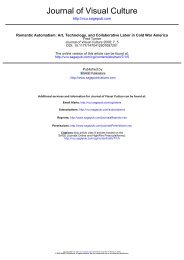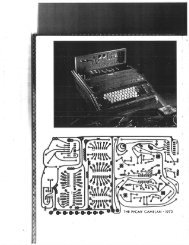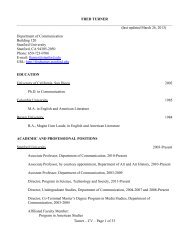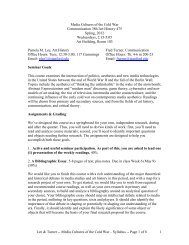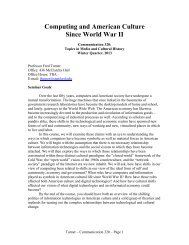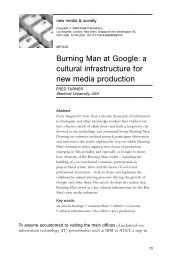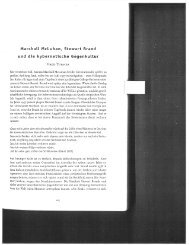The Family of Man and the Politics of Attention in ... - Public Culture
The Family of Man and the Politics of Attention in ... - Public Culture
The Family of Man and the Politics of Attention in ... - Public Culture
Create successful ePaper yourself
Turn your PDF publications into a flip-book with our unique Google optimized e-Paper software.
<strong>Public</strong> <strong>Culture</strong><br />
American farmer looked bravely <strong>in</strong>to <strong>the</strong> distance. Below him, Bayer, Steichen,<br />
<strong>and</strong> S<strong>and</strong>burg had written, “War — <strong>the</strong>y asked for it — now, by <strong>the</strong> liv<strong>in</strong>g God,<br />
<strong>the</strong>y’ll get it.”<br />
<strong>The</strong> exhibition <strong>the</strong>n opened onto scenes <strong>of</strong> American troops <strong>in</strong> tra<strong>in</strong><strong>in</strong>g, <strong>of</strong><br />
airmen ra<strong>in</strong><strong>in</strong>g down <strong>in</strong> parachutes on an unseen enemy, <strong>and</strong> <strong>of</strong> bombs do<strong>in</strong>g <strong>the</strong><br />
same. “Smooth <strong>and</strong> terrible birds <strong>of</strong> death,” captioned S<strong>and</strong>burg, “smooth <strong>the</strong>y fly,<br />
terrible <strong>the</strong>ir spit <strong>of</strong> flame, <strong>the</strong>ir hammer<strong>in</strong>g cry, ‘Here’s lead <strong>in</strong> your guts.’ ” Visitors<br />
passed vistas <strong>of</strong> American warships, sail<strong>in</strong>g on w<strong>in</strong>dblown, choppy seas — <strong>in</strong><br />
S<strong>and</strong>burg’s words, “Hunt<strong>in</strong>g <strong>the</strong> enemy, slugg<strong>in</strong>g, pound<strong>in</strong>g, blast<strong>in</strong>g.” At last, at<br />
<strong>the</strong> end <strong>of</strong> <strong>the</strong> exhibition’s road, visitors confronted an enormous, floor- to- ceil<strong>in</strong>g,<br />
panoramic overhead photograph <strong>of</strong> row upon row <strong>of</strong> American soldiers march<strong>in</strong>g.<br />
<strong>The</strong>se soldiers might well have looked like <strong>the</strong> anonymous masses shown <strong>in</strong><br />
fascist exhibitions from <strong>the</strong> thirties had <strong>the</strong>y not featured <strong>in</strong>set images <strong>of</strong> middleaged,<br />
white, <strong>and</strong> mostly rural American couples — clearly meant to be <strong>the</strong> symbolic<br />
parents <strong>of</strong> <strong>the</strong> marchers — sitt<strong>in</strong>g <strong>in</strong> front <strong>of</strong> <strong>the</strong>ir houses, on <strong>the</strong>ir s<strong>of</strong>as,<br />
<strong>and</strong>, <strong>in</strong> one case, outdoors on what looked like a review<strong>in</strong>g st<strong>and</strong>. Visitors to this<br />
f<strong>in</strong>al scene were surrounded — by American troops, but also by <strong>the</strong> same sorts <strong>of</strong><br />
American citizens <strong>the</strong>y had seen at <strong>the</strong> start <strong>of</strong> <strong>the</strong>ir journey through <strong>the</strong> show.<br />
Where a fascist exhibition might have asked its viewers to melt <strong>in</strong>to an anonymous<br />
mass, this f<strong>in</strong>al set <strong>of</strong> images asked Americans to preserve <strong>the</strong>ir <strong>in</strong>dividuality,<br />
<strong>the</strong>ir roots, even as <strong>the</strong>y formed <strong>in</strong>to a fight<strong>in</strong>g mach<strong>in</strong>e.<br />
Such an appeal struck a deep chord <strong>in</strong> audiences. Across <strong>the</strong> summer <strong>of</strong> 1942,<br />
more than eighty thous<strong>and</strong> people visited <strong>the</strong> exhibition. 25 Reviewers fell over<br />
<strong>the</strong>mselves to praise it. “It would not at all amaze me to see people, even people<br />
who have thought <strong>the</strong>mselves very worldly, nonchalant or hard- boiled, leave this<br />
exhibition with brimm<strong>in</strong>g eyes,” wrote critic Edward Alden Jewell <strong>in</strong> <strong>the</strong> New<br />
York Times. Jewell particularly praised <strong>the</strong> exhibition’s ability to reveal essential<br />
aspects <strong>of</strong> American character <strong>and</strong> to help visitors feel <strong>the</strong>m as <strong>the</strong>ir own. If o<strong>the</strong>r<br />
exhibitions had simply depicted “a nation at war,” wrote Jewell, this one “reveals<br />
<strong>the</strong> very fiber <strong>of</strong> <strong>the</strong> nation itself.” By draw<strong>in</strong>g visitors down a road, by array<strong>in</strong>g<br />
images above <strong>and</strong> below eye level, <strong>and</strong> by mix<strong>in</strong>g images <strong>of</strong> life at home with life<br />
<strong>in</strong> <strong>the</strong> army, Jewell argued that <strong>the</strong> exhibition drew visitors <strong>in</strong>to a new form <strong>of</strong><br />
emotional citizenship. “I th<strong>in</strong>k no one can see <strong>the</strong> exhibition without feel<strong>in</strong>g that<br />
he is a part <strong>of</strong> <strong>the</strong> power <strong>of</strong> America,” wrote Jewell. “It is this <strong>in</strong>escapable sense<br />
<strong>of</strong> identity — <strong>the</strong> <strong>in</strong>dividual spectator identify<strong>in</strong>g himself with <strong>the</strong> whole — that<br />
makes <strong>the</strong> event so mov<strong>in</strong>g.” 26<br />
70<br />
25. Christopher Phillips, “Steichen’s ‘Road to Victory,’ ” Exposure 18, no. 2 (1980): 38.<br />
26. Edward Alden Jewell, “Portrait <strong>of</strong> <strong>the</strong> Spirit <strong>of</strong> a Nation,” New York Times, May 24, 1942.



